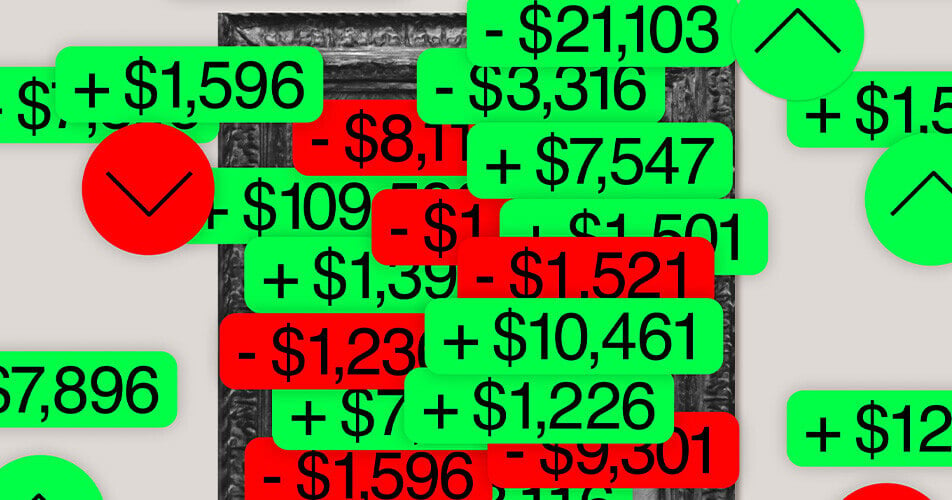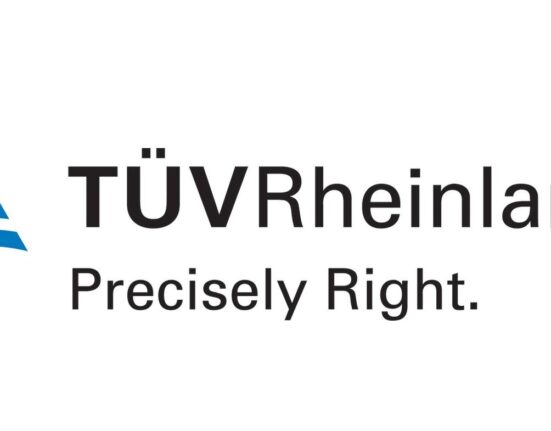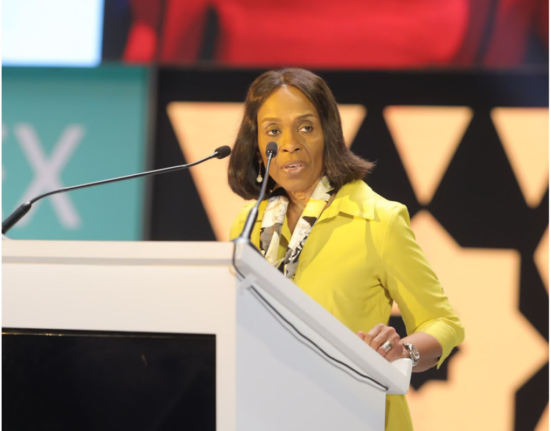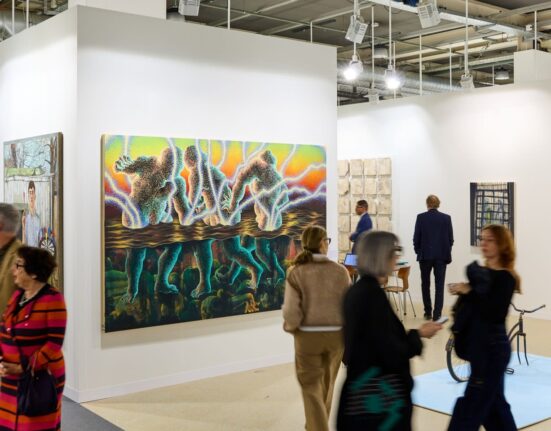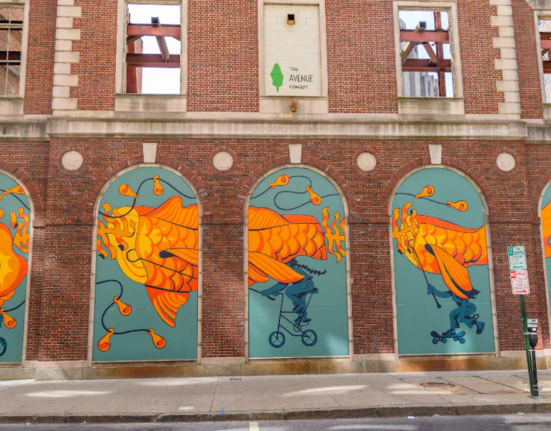Imagine, for a second, that you have a spare $100,000. For some reason, you decide to spend it on art. You’ve never bought art in a serious way before. Let’s say you live in a suburb of a large American city but not a major art hub. Philadelphia, perhaps. You visit the city’s art museum a few times a year or, if you’re feeling adventurous, the Institute of Contemporary Art. When in New York, you might visit The Met or MoMA, but not every time. You rarely go to commercial galleries, but because you work in finance, you have a decent idea of how they operate. You have colleagues who have used art advisors in the past, but you don’t see the need for one now. You’re interested in painting, maybe some ceramics.
You begin doing some research online, and within a few clicks are scrolling through Artsy, a digital marketplace that allows you to discover painters within your budget. You start following a few of your new favorites and notice that their works are being sold at an online auction hosted by Artnet. You create a profile and begin bidding in the “Abstracted” auction. You enjoy the process, which recalls the thrill of gambling, so you use Artprice to search for in-person auctions to attend in New York. You want to make sure you’re not investing at a risky moment, so you pay for some financial reports from ArtTactic, which give an overview of consumer trends in contemporary painting. You don’t want to appear out of your depth at upcoming auctions, so you decide to brush up on your art history using ArtFacts, discovering from its rankings that Gerhard Richter is the world’s most important living artist. You also learn that Gagosian is the world’s most influential gallery, and that several other heavy hitters are clustered together in Chelsea. You end up downloading Limna, the ArtFacts-owned app which gives algorithmically generated price appraisals for artworks. With all this new information, you now feel pretty confident that you can spend your $100,000 wisely—and you haven’t even had to leave your condo, or talk to anyone, or see any art in person.
Does this type of scenario actually occur? Regrettably, yes. It’s a simplified model, but if you have any kind of economic incentive to prod the “next generation” of collectors to participate in the art market, then you likely believe that at least some of the Philly-finance-guy’s path plays out in reality. If you work for any of the art data companies that Philly-guy hit up, then it’s your job to make sure that he tells all his friends about your product—and to make sure that there are people like him not just in Los Angeles, London, and Paris, but Tokyo, Singapore, Shanghai, and Seoul as well.
The more traditional art market (comprising commercial galleries, dealers, wealthy collectors, and auction houses) doesn’t really care about people like Philly-guy, although it’s worth keeping an eye on which services he’s using. Art market reports can reassure clients, and innovations in online viewing rooms and sales can be copied in-house to bolster revenue (David Zwirner Gallery has been particularly adept at this since the pandemic). If you’re Christie’s or Sotheby’s, reputation does most of the work for you. But partnering with firms like ArtTactic can help demystify the opaque auction world for potential customers. It also feeds a sense of aspirational longing among outsiders. “Peak Performance,” a 2023 report by Sotheby’s and ArtTactic, tells us that Jean-Michel Basquiat slipped from first to third place in overall value of work sold from 2021 to 2022 ($436.4 million down to a pitiable $197.1 million). And that, in sales rankings for women artists, the top four remained the same during that period: Yayoi Kusama followed by Joan Mitchell, Cecily Brown, and Agnes Martin. If you’re neither a Philly-guy nor an art world insider but are a student, academic, emerging artist, or perhaps even just someone who likes and cares about art, then at this point it’s reasonable to think that you might be starting to feel a little alienated, or slightly sick.
Marveling at the scale of greed is less worthwhile than examining how this system is upheld, and whether attempts to alter it are sincere and credible.
The worst excesses of the art market are well-documented. Some are common to the upper financial echelons of all sectors: intense wealth concentration, a deliberately obscure idiom, an intimidating social environment. Some features are exclusive to art, in particular how works are traded. Market manipulation is open and widespread, regulation is effectively nonexistent, money laundering is rife. The profit motive bleeds into the organization and dynamics of the broader art world. To the extent that a significant portion of professional artistic activity—from education and production to curation, display, and publishing—relies on wealth created from this engine, it will continue to be shaped in its image. Most of the mainstream art world’s problems can be blamed on the market: the elevation of mediocre works in public institutions; the erosion of critical culture; the focus on blockbuster exhibitions; artwashing and reputation management; the lingering air of profound sycophancy.
But the true picture is, of course, more complex, not least because the galleries from which dealers operate fund and support lots of excellent art. Marveling at the scale of greed is less worthwhile than examining how this system is upheld, and whether attempts to alter it are sincere and credible. Which brings us back to the unimaginatively named tech platforms used by Philly-guy. These companies share a simple belief: the introduction of data analytics and artificial intelligence can optimize art buying, from both a cultural and investment perspective. This idea is nothing new; companies like Robin Duthy’s Art Market Research (AMR) have been running financial indexes for fine art, watches, and antiques since 1978. So how should we view these platforms? Skepticism, if applied, needs to be applied equally, to wannabe “disruptors” as much as the establishment.
David A. Ross, former director of the Whitney, ICA Boston, and the San Francisco Museum of Modern Art, put high level analytic-based collecting in simple terms for me: “Like eating the menu instead of the food in a restaurant.” An increasing number of transactions now take place without the buyer seeing the artwork in paradoxical, anti-aesthetic exchanges. Art tech platforms often adopt the language of social justice to cloak their second aim: to coax more people into buying art, to democratize and diversify a historically elitist practice. ArtTactic, we’re told, is “driven by the desire to make the art market more transparent and less asymmetric.” “For who?” might be a sensible follow-up question. (Its founder used to work at JP Morgan; Artnet’s chief data scientist is a former BNP Paribas Fortis trader). All art world players recognize that art is both a cultural and commercial entity. What makes decoding motivations difficult is that those who succeed can move deftly between the two poles as necessary.
This balance is key to what these platforms sell—the idea, as well as the artifacts, of culture. Most rely on an uneasy mix of investor-speak and idealism in their communications. Last year, Artprice CEO Thierry Ehrmann wrote that recent price acceleration was “driven by a growing number of collectors wishing to participate in the art market via exchanges that express an essential part of our humanity.” (He doesn’t really say what this is). Artsy publishes universally generous write-ups, effectively acting as a retail promotion arm and further enclosing the relationship between critical acclaim and market performance. (Artnet News is more credible, but the conflict remains.) Inevitably, this blurring leads to trend forecasts which view everything through the lens of capital. “Black portraits are still selling well,” according to an Artprice piece from August describing such works as a “highly fashionable figurative genre.” None of this is untrue, but it is undeniably grating. Culture as commodity. Blackness as bull market.
Rankings can feel particularly counterintuitive, quantifying personal taste using clumsy and inconsistent metrics. ArtFacts’s new gallery ranking (slogan: “Art is sexy, so is data”) uses criteria such as Talent Discovery (“the number of top artists a gallery has shown within the artist’s first year of their career”) and Talent Representation (“the number of trending artists a gallery has shown over an extended period”). Neither of these account for how commercial galleries actually work. As artists achieve higher prices, they often move to dealers capable of managing and replicating the inflated sums, so representation is a self-fulfilling, but not always logical, path. Artists show with multiple galleries in different geographic regions, so can remain dormant in one for years while thriving elsewhere. There’s also the poaching of promising artists from smaller galleries by blue chip dealers, skewing Talent Discovery as a metric. And there’s the fact that representation often rests on personal relationships. Artists move dealers to change focus: having a better chance of entering museum collections or being supported working in a new medium, for example. (A recent New Yorker profile of Larry Gagosian offers some colorful examples.) The gallery model is in need of reform, but misrepresenting it in pursuit of quantification hardly helps artists. For everyone else, rankings are just distorted information packaged as insight—an imperfect substitute for going outside, or following your nose, or looking up galleries and artists yourself.
Even among insiders, there’s consensus that treating art as a mappable investment is flawed. “The results for the performance of art as an asset are driven by very low levels of often corrupted or partial data, and should be treated with caution and even skepticism.” That’s Iain Robertson, head of art business studies at Sotheby’s Institute of Art, in 2016. Ironically, the service listings of Sotheby’s own art advisory department read like any other bespoke wealth management company: collection management; legacy and fiduciary planning; market access and intelligence. Melanie Gerlis, the Financial Times’ art market columnist, went further in her 2014 book Art as an Investment?, where she describes art data as the “chain of limited and often subjective information which renders itself almost meaningless by the time it is collated.”
This hasn’t stopped these tools from embracing the financial models and technologies favored by their corporate backers. Artsy, whose early investors included Gagosian and Russian collector Dasha Zhukova, was a frontrunner in the tagging strategy which anticipated much of today’s AI-powered trendspotting. Artsy’s whole model of recommendation is based on its Art Genome Project, a classification system whereby over one thousand characteristics are variously assigned to the site’s searchable artists and artworks. “Unsettling,” “highly ornamented,” “time,” and “reflections” are some of the more obscure and subjective labels, or “genes.” The connections between these tags generate clusters of work for customers to browse, the same as any other online retailer. “A student unfamiliar with Jackson Pollock might learn more about him via the ‘splattered/dripped gene,‘” Artsy says. This might be vaguely endearing if it wasn’t so depressing.
In 2017, Artsy acquired and integrated ArtAdvisor, a startup that uses machine learning to enhance artist cross-referencing and insights. (Curiously, ArtAdvisor was cofounded by Lucas Zwirner, son of mega-gallerist David and director of the gallery’s books division.) Artnet broke the ground first, buying Tutela Capital SA in 2016, with The Art Newspaper noting that the analytics firm already ran an art valuation metric used by banks and hedge funds. Sotheby’s followed two years later, acquiring AI startup Thread Genius, which uses image recognition and natural language processing to suggest artists or works based on image descriptions and search data. The company was set up by two ex-Spotify engineers, one of whom, Ahmad Qamar, is the sole patent author of the “Discover Weekly” algorithm. Beyond just changing the way we view art, there is serious money to be made upfront. In 2015, The New York Times reported that ArtRank, which uses algorithms to group emerging artists, was charging its ten clients $3,500 a quarter for its curated lists.
This landscape starts to resemble a stock exchange crossed with a sophisticated online retailer. Experienced art dealers are seasoned traders, and those going after “next gen” collectors are increasingly touting AI as an alternative to traditional investment advice. The value of personal taste has been replaced by an obsession with volume and reach: more customers, preferably young, in more regions, spending more money, more often. And if personal taste is displaced at the entry-level of the market, the values of connoisseurship, curation, and seriousness are also at risk at the institutional end. Ross points to a significant shift on U.S. museum boards in the last twenty years (he left SFMOMA in 2001), commenting that boards—and therefore the artwork acquisition process—“are now rife with conflicts of interest that cannot be controlled.” Zhukova, for example, is on the board of the Met, the Los Angeles County Museum of Art, and Gagosian, alongside a host of investors and CEOs including Snap’s Evan Spiegel and Dior’s Delphine Arnault.
The creeping influence of the financial sector’s technologies and personnel into the art market rankles.
Put crudely, the museum acquisition process can become a vehicle for ensuring the long-term value of artworks in board members’ private collections. This also leads to sometimes incoherent exhibitions of works drawn from a single collection. Ross recalls his time at SFMOMA and the Whitney: “We didn’t think of investing in art—we made acquisitions on behalf of the public using the best of our collective curatorial intelligence.” But as curators and even directors are distanced from major decision-making, “the art world’s value system has become fully corrupt,” he says. Now teaching at New York’s School of Visual Arts, Ross is at pains to emphasize that all is not doomed, that there are informed board members across American institutions, but prospects appear bleak.
Much of this trajectory follows familiar debates around technology and taste. Can algorithms ever interpret a piece of art, music, or literature more effectively than a human being? Art is unique compared with other entities. The lack of inherent truth runs through not just its cultural standing but its financial value, separating it from albums, books, and TV shows. It has always been this way. The emotional responses art evokes cannot be explained logically, and so its financial valuations have reproduced this irrational organization—sometimes to absurd and deplorable ends. Taste is fundamentally entwined with capital, which, over time, warps—and sometimes dictates—collective ideas of historic and cultural worth. “After the credit crisis, taste became more muted,” Gerlis writes of the Great Recession’s influence on collecting. Robertson agrees: “With shifts in global wealth brought about by geopolitical and economic transition, taste may change dramatically.”
As taste becomes increasingly financialized, there is a legitimate case for democratizing parts of the art world. The question is whether collecting is the best place to start, rather than, say, arts education or museum structures. Enabling more people to buy art does put money in artists’ pockets, but it is not the only solution to the inequities that many artists experience in sustaining a career. It’s also worth remembering that championing what Ross terms “curatorial intuition” as a counterweight to algorithmic decision-making is not a morally neutral stance. Institutional art history remains elitist and Western-focused. Empowering a select few curators to determine a society’s cultural direction brings its own problems, not to mention the insidious and sometimes criminal ways individuals can exercise and maintain this power (see Anthony d’Offay and the Sacklers). There is tyranny in the majority but also in a cultural pyramid crowned by plutocracy. Reading about Gagosian’s dark arts does little to calm fears of a cabal at the top of the art world where merit, art-historical significance, and the public interest are subservient to profit.
This isn’t to say that technology doesn’t have a place in art. Or that it hasn’t improved knowledge-sharing, or that a globalized art market hasn’t allowed many more non-Western artists to thrive. But the creeping influence of the financial sector’s technologies and personnel into the art market rankles. If those encountering art for the first time are denied the opportunity to explore it of their own volition, deferring to digitized recommendations will become not just accepted but expected. The critic Robert Hughes derided the next generation of collectors as early as 1984: “Most of the time, they buy what other people buy. They move in great schools, like bluefish,” he said. Treated now just as data points—faceless sequences of online decisions—new collectors might yet yearn for the days of being compared to sentient beings.

